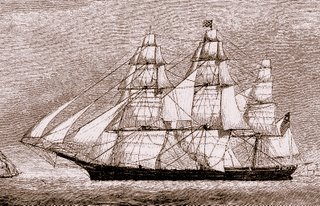Discovering the Adventure:
49ers Travel Around the Horn to
San Francisco
Around the Horn in 1849 with the 49ers
This sounds so daunting to us today - boarding a sailing ship in the 1840s and 1850s to travel 16,000 miles around the deadly tip of Cape Horn with its monstrous waves, terrifying winds, and frigid temperatures.
The Journey Around the Horn
 1849 Era Clipper Ship; Artist Unkinown
1849 Era Clipper Ship; Artist UnkinownSome of the gold rushers traveled around the horn - particularly those who lived near the Eastern Seaboard or arrived there from foreign lands.
American ships' captains had excellent reputations for traversing the vagaries of both the Atlantic and the Pacific oceans in relative safety.
And many of the ships of the day were equipped with steam engines, giving them a distinct advantage over vessels that were governed by wind alone.
It was about 16,000 miles to travel the Atlantic from New York, Boston, or New Orleans along the Eastern coast of the three Americas around the Horn, then north along the Western coast of those same Americas before reaching San Francisco - the Gateway to the Goldfields.
But the journey took no more than the four to six months it would take to travel overland (and sometimes took much less than that - the record was 89 days, set by the Flying Cloud).
Plus, it was considered to be a safer, and much more comfortable trip. The ships were built to withstand the vagaries of the oceans' weather, and during good weather the men had the advantage of enjoying the beauty of the sea and stops in exotic ports along the way.
One of the downsides of this trip however, was that the men did not (could not) bring their families with them. Those who traveled overland by covered wagon at least had the option.
There were stops along the way to resupply, with the ships taking on food, water, and wood for the steam engines.
Between stops were long spells of boredom that were occasionally interspersed with periods of abject terror - as when the ship traveled through dense fogs, bringing on fears of collision, or through fierce storms and heavy seas, leading to visions of the ship being rent asunder with all hands lost at sea!
A shorter route, but one wrought with its own perils, was to cross the land at the Isthmus of Panama.
Those who chose this path disembarked at Chagres, Panama, used river canoes and mules to cross the Isthmus through rainy, seemingly impenetrable jungle, and reached Panama City on the Pacific side within about three days.
If they didn't contract a tropical disease like malaria, and if a ship was waiting for them in Panama City, the timing for the total trip could be as little as six weeks - twelve weeks at most!
All in all, sailing to San Francisco seemed like a good idea to many - over 25,000 traveled via sailing ship.
And, it didn't cost any more than going overland; both trips could be done for about $400.
If you're interested in how other 49ers got to California, check here:
- Going to California
There were basically two ways to get to California during the Gold Rush. - Overland by Covered Wagon
The other way to get to the California goldfields was to spend up to 6 months walking alongside a prairie schooner.
For what they did once they arrived, try these articles:
- San Francisco Gold Rush
Follow the self-guided walking tours called "The Barbary Coast Trail" and "The Gold Rush Trail". - Follow the Sacramento River
Want to know which route the 49ers took from San Francisco to Sacramento City? - Old Sacramento
What did the 49ers find when they reached Sacramento City? - Sutter's Fort
Sutter's Fort - a step back in time!
Please continue your exploration of what Northern California has to offer by using the Nav Bars in the left and right columns or by using the links at the bottom of the page.
Like what you're finding here at Discovering Northern California? Then please share with the Social Network of your choice.
And thanks for coming!
Related Pages
California Gold Rush
California Gold Rush
Discovery of Gold
Getting to California
Gold Rush Trail
Gold Rush Sites
Gold Panning
Related Articles
Gold Country
Related Pages
More CA History
1906 Earthquake
California Gold Rush
CA Gold Rush Sites
California Missions
Sonoma Plaza History
Sutter's Fort
Related Pages
Hints & Tips
Beach Safety Tips
Best Kept Travel Secrets
Family Camping Tips
iPhone Travel Apps
Nude Beaches
Tide Pool Tips
Travel Sites We Love
Travel Tips
Whale Watching Tips
Wine Tasting Tips
Winter Driving Tips
Related Pages
Things To Do
Activity Village
Attractions
Beaches
Beer Lovers Delight
Burney Falls
Camping
Casa de Fruta
Day Trips
Gold Panning
Gold Rush Sites
Healdsburg
Historic Grass Valley
Lake Shasta Caverns
Lodi
Missions
Nevada City
RV Destinations
Ski Resorts
Tide Pool Tips
Travel Tips
Weekend Trips
Whale Watching
Wine Tasting
Related Pages
Free Things To Do
Free in Big Sur
Free in Chico
Free in San Francisco
Free in Sonoma
Related Pages
Insider Secrets
Best Kept Travel Secrets
Best Winter Whitewater
Boring Road? Nope
CA Admission Day
Climbing at Castle Rock
Crabbing Spots
Dream of Dreams
Fall in Eastern Sierras
Ghost Stories
Glass Beach
Great Stays, Low Pays
How to be a Valley Girl
Jade Beach
Lake Shasta Caverns
Lassen Volcanic SP
Lost Coast
Mono Lake
Moss Landing: Whales
New Clairvaux Abbey
Panning for Gold
Pygmy Forest
Mendo to Eureka
RV Destinations
SF Great Places to Eat
SF: More About Eating
SF Neighborhoods
SF Giants Baseball
Santa Cruz: Memories
Santa Cruz: Old Friends
Sonoma Cooking Class
Sonoma History
Sonoma Top Wine Stop
Tahoe: Discovery Trail
Underground Gardens
Yosemite: Family Hikes
Yosemite: High Country
YNP: Off the Beaten Path
Yosemite: Taft Point
Ziplines